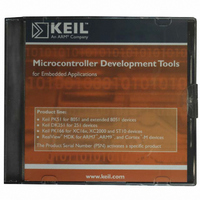MDK-ARM Keil, MDK-ARM Datasheet - Page 146

MDK-ARM
Manufacturer Part Number
MDK-ARM
Description
KIT REALVIEW MCU DEVELOPMENT
Manufacturer
Keil
Type
Compiler and IDEr
Specifications of MDK-ARM
For Use With/related Products
ARM MCUs
Lead Free Status / RoHS Status
Lead free / RoHS Compliant
- Current page: 146 of 156
- Download datasheet (3Mb)
146
Chapter 6. RL-CAN Introduction
CAN arbitrates its messages by a method called “non-destructive bit-wise
arbitration”. In the diagram, three messages are pending transmission. Once the
bus is idle and the messages are synchronized by the start bit, they will start to
write their identifiers on to the bus. For the first two bits, all three messages
write the same logic and, hence, read back the same logic, so each node
continues transmission. However, on the third bit, nodes A and C write dominant
bits, and node B writes recessive. At this point, node B wrote recessive but reads
back dominant. In this case, it will back off the bus and start listening.
Nodes A and C will continue transmission until node C writes recessive and node
A writes dominant. Now, node C stops transmission and starts listening. Node
A has won the bus and will send its message. Once node A has finished, the
nodes B and C will transmit. Node C will win and send its message. Finally,
node B will send its message. If node A is scheduled again, it will win the bus
even though the node B and C messages have been waiting. In practice, the
CAN bus will transmit the message with the lowest value identifier first.
RL-CAN Driver
As mentioned above, CAN has been widely adopted for distributed control
within embedded systems. Today, just about all microcontroller families include
a variant, or variants, with a CAN controller peripheral. However, each
manufacturer’s CAN controller has a different set of special function registers
and features. The RL-ARM library includes a dedicated CAN driver, which
provides a standard programming API for all supported microcontrollers. The
CAN driver uses RTX message queues to buffer data before it is transmitted or
received. The RL-CAN driver provides a quick and easy way to implement a
CAN network. The RL-CAN driver also provides code portability, in case you
need migrating code to another microcontroller.
First Project
Unlike the other middleware components within the RL-ARM library, the RL-
CAN driver must be used with RTX.
The RL-CAN driver consists of
two C modules and associated
header files. The first module,
, is a generic layer
RTX_CAN.c
driver, which provides the high
Related parts for MDK-ARM
Image
Part Number
Description
Manufacturer
Datasheet
Request
R

Part Number:
Description:
KIT REALVIEW MCU DEVELOPMENT
Manufacturer:
Keil
Datasheet:

Part Number:
Description:
Development Software SUPPORT EXTENSION FOR MDK-ARM-B
Manufacturer:
Keil Software

Part Number:
Description:
Development Software SUPPORT EXTENSION FOR MDK-ARM
Manufacturer:
Keil Software

Part Number:
Description:
KIT REALVIEW MCU DEVELOPMENT
Manufacturer:
Keil
Datasheet:

Part Number:
Description:
Development Software MCU DEV KIT FOR ARM UPG TO FLOATING LIC
Manufacturer:
Keil Tools

Part Number:
Description:
Development Software MCU DEV KIT FOR ARM W/ FLOATING LICENSE
Manufacturer:
Keil Software

Part Number:
Description:
Development Software MCU DEV KIT FOR ARM uVISION & C++ & RTX
Manufacturer:
Keil Tools

Part Number:
Description:
Development Software SUPP LICENSE RENEWAL 90+ DAYS NO TECH SUP
Manufacturer:
Keil Software
Part Number:
Description:
KEIL C-COMPILER INTERNATIONAL
Manufacturer:
Silicon Laboratories Inc

Part Number:
Description:
BOARD EVAL FOR LPC213X ARM MCU
Manufacturer:
NXP Semiconductors
Datasheet:
Part Number:
Description:
K60N512 Keil Tower Kit
Manufacturer:
Freescale Semiconductor
Datasheet:










